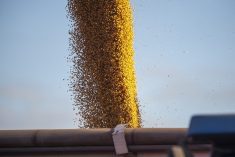Geopolitical concerns, trumped by disaster on top of disasters in Japan, against a backdrop of near-“burdensome” supply, have piled on wheat in the Canadian Wheat Board’s latest 2011-12 and 2010-11 pool return outlooks (PROs).
Wheat values in the CWB’s March PRO for the 2011-12 crop year are down $23 to $28 per tonne, while those same values have slipped $1 to $10 per tonne in the board’s latest 2010-11 PRO.
Both the new-crop and old-crop PROs were released Thursday, showing 2011-12 durum down $24 to $38 per tonne and 2010-11 durum down $16 to $18 per tonne. New-crop Pool A feed barley values are down $26 per tonne, new-crop malting barley down $9 per tonne and 2010-11 barley values unchanged.
Read Also

U.S. pulse group commits to doubling production in five years
The pulse industry in the United States has plans to double production and consumption of pulse crops by 2030, USA Pulses announced at their annual conference held in Spokane, Washington, July 7-10.
Wheat
The ongoing crisis in Libya and the earthquake, tsunami and ensuing nuclear meltdown threat in Japan “have played significant roles in keeping both the broader economic and agricultural markets uncertain and volatile,” the CWB said Thursday.
The supply-and-demand balance for U.S. corn will provide “much of the impetus” for a bear or a bull market, the board said. The 2010-11 corn balance is “critically tight” and projected 2011-12 U.S. corn acreage is “still a moving target” with estimated from 90 to 94 million acres.
“In terms of sustaining the bull market, the wheat story is far less compelling towards the upside,” the board said. “There are abundant stocks, and production potential for 2011-12 outside of North America is positive and seems to be improving.”
It’s worth noting, the CWB said, that the wheat market in fact dropped “significantly” before Japan’s earthquake, due to the heavy nature of the supply-and-demand balance sheet.
The 2011-12 March PRO shows high-protein No. 1 Canada Western red spring (CWRS, 14.5 per cent) down $23 per tonne from February levels, at $342. No. 4 CWRS is down $25, at $253 per tonne, while No. 1 Canada Prairie spring white (CPSW) is down $28, at $261.
No grain has yet been priced for 2011-12 crop year deliveries of wheat, the CWB said, with wheat pricing levels expected to reach about 25 per cent by the end of September.
The latest 2010-11 PRO, meanwhile, finds that while wheat is “relatively abundant,” old-crop supplies of higher-quality wheat remain tight worldwide.
“Quality premiums will not return to more normal ranges until the world is comfortable that 2011-12 quality results will be normal or better,” the board wrote. “However, demand must be present and willing to pay high premiums for protein and quality to support the current wide spreads between high- and mid-quality wheat.”
No. 1 CW red winter is down just $1 per tonne from February values in the 2010-11 March PRO, at $272, while No. 1 CWRW (11 per cent) is down $2 at $274. No. 1 CPSW is down $5 per tonne at $271, No. 1 CWRS (13.5 per cent) down $9 at $344, and No. 4 CWRS down $10 at $256.
The CWB said it has priced about 72 per cent of its expected 2010-11 deliveries of wheat, and expects to reach about 89 per cent priced by the end of May.
Durum
The 2011-12 durum outlook has been influenced even more deeply by the same macroeconomic and geopolitical uncertainty as the wheat outlook, the CWB said.
Furthermore, “weather conditions in North African and European Union durum-growing regions continue to support a favourable crop outcome,” the board said. “However, the grain is not in the bin and only a completed harvest with conditions similar to current conditions will cement the positive potential.”
Also, Canadian durum acreage is now projected to rise by 23 per cent and production to increase by over a million tonnes, the board said.
High-protein No. 1 CW amber durum (CWAD), 14.5 per cent, is down $38 per tonne in the March 2011-12 PRO compared to February values, dipping to $345 per tonne. No. 2 CWAD (11.5 per cent) is also down $38, at $310, while No. 4 CWAD is down $24 at $236.
In the latest 2010-11 PRO, meanwhile, the board noted the same crises and macroeconomic issues affecting the durum market. However, it also noted the appreciation of the euro since the February PRO, where a stronger euro can have positive effects on EU imports and negative effects on the bloc’s exports.
The latest 2010-11 durum PRO finds No. 1 CWAD (14.5) at $301 per tonne, down $18 from February levels, and No. 3 CWAD down $16 at $245. No. 4 CWAD is down $6 per tonne at $239, while No. 5 CWAD is flat at $234.
Feed barley
Canadian feed barley is expected to find trouble competing on price in the Saudi Arabian market, as world barley production is now expected to rise 11 per cent from last year. The Black Sea region, Russia and Ukraine included, now expects to harvest over 30 million tonnes in 2011-12, up 12 million from 2010-11 levels.
While Canadian feed barley production is expected to remain below the five-year average, a return to a more normal grade pattern for both wheat and barley in Western Canada should dial back feed-grade wheat supplies and “return barley to prominence in the Canadian feed ration,” the CWB said.
Pool A feed barley in the 2011-12 March PRO is pegged at $231 per tonne, down $26 from the February level.
General tightness in the coarse grain supply-and-demand balance supports nearby barley prices against an “unspectacular” global trade picture, leaving the CWB’s 2010-11 March PRO for Pool B feed barley flat at $238 per tonne.
Malting barley
Presuming “average” crop conditions worldwide, the 2011-12 malting barley supply is projected to “significantly” increase, the CWB said.
“Demand remains ill-defined but the world needs malting barley and a return to a more normal quality distribution will be positive for import volumes,” the board said. “In short, the greater the demand for higher-quality malting barley in the global market — with China of particular interest — the more potential there will be for malting barley prices to stabilize at higher absolute levels.
The March 2011-12 PRO pegs Select CW two-row and six-row malting barley at $328 and $311 per tonne, respectively, both down $9 from February levels.
For the remainder of the 2010-11 crop year, malting barley demand is “fairly well covered,” the board said, noting there’s not much quality malting barley available to buy.
“Offshore customers understand the scarcity of quality and many have reduced or deferred demand until new crop,” the board said.
Select CW two-row and six-row malting barley values in the March 2010-11 PRO remain flat from February at $253 and $236 per tonne, respectively.
The CWB’s next round of PROs for both the 2011-12 and 2010-11 crop years are due out April 28.















